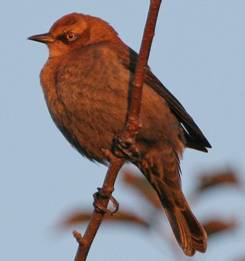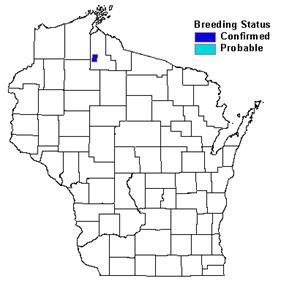Photo by Scott Franke


Status/Protection
- Global Rank: G4 Key to global and state ranks
- State Rank: SNB
- WBCI Priority: SGCN, PIF, State Special Concern
Population Information
The Federal BBS information can be obtained at http://www.mbr-pwrc.usgs.gov/bbs/bbs.html by clicking on Trend Estimates and selecting the species in question. All estimates are for time period (1966-2005).
- Federal Breeding Bird Survey: significant decline
- Federal Breeding Bird Survey (WI): N/A
- Federal Breeding Bird Survey (BCR 23): N/A
- Federal Breeding Bird Survey (BCR 12): significant decline
- WSO Checklist Project: decline (1983-2007)
Life History
- Breeding Range: Northern Alaska east to Newfoundland and the northern New England states (Avery 1995).
- Breeding Habitat: Black Spruce, Open Bog-Muskeg, Alder Thicket.
- Nest: Cup; 0.5-6 meters above ground and usually near water (Ehrlich et al. 1988, Avery 1995).
- Nesting Dates: Eggs: mid-May to early June, but few data for Wisconsin (Robbins 1991); elsewhere in range early May to mid-June (Avery 1995).
- Foraging: Ground glean (Ehrlich et al. 1988).
- Migrant Status: Short-distance migrant.
- Habitat use during Migration: Plowed agricultural fields with grain stubble, pastures, swamp edges (Avery 1995); shorelines of Lake Superior and other inland waterways in Wisconsin.
- Arrival Dates: Mid-May in spring; mid-September in fall (Robbins 1991).
- Departure Dates: Early May in spring; early November in fall (Robbins 1991).
- Winter Range: From Massachusetts west through southern Michigan to Nebraska, south to Gulf Coast of Texas and Florida and along Atlantic coast (Avery 1995).
- Winter Habitat: Swamps, edges of ponds with nearby agricultural fields (Avery 1995).
Habitat Selection
Breeding habitat in Canadian provinces and Alaska consists of black spruce bogs with sphagnum understory, alder/willow bogs, and edges of beaver ponds or other wooded wetlands. Disturbances such as fire, windthrow, beaver activity, and logging practices that create small forest openings can be favorable for this species (Avery 1995). Few breeding records exist for Wisconsin. The most recent breeding record occurred in 1999 when a family group of adults and three young were recorded in a remote wetland area “overhung with dense tag alders” in Ashland County (Sumner Matteson, pers. comm.). Rusty Blackbirds forage in agricultural fields with crop stubble, plowed agricultural fields, and the edges of swamps, ponds, or marshes during migration (Avery 1995). These same habitats are used in the winter by those few flocks that remain in southern Wisconsin.
Habitat Availability
Because the Rusty Blackbird is an extremely rare breeder in Wisconsin, little is known about breeding habitat preferences within the state. Wooded swamp and bog habitats cover approximately 8% of the northern Wisconsin landscape (Hoffman and Mossman 1993) but are much reduced in southern Wisconsin due to draining and clearing for agriculture (WDNR 2005). Approximately four million hectares of wetland habitats remain in the state, although these habitats also are much reduced from historic proportions (WDNR 1995). The open agricultural habitats used during migration and winter are abundant throughout the state.
Population Concerns
The Rusty Blackbird may be North America’s most rapidly-declining avian species. Historical data indicate a decline in Rusty Blackbird populations for at least the last century, possibly at an accelerated rate over the last few decades (Greenberg and Droege 1999). Breeding Bird Survey (BBS) data corroborate this claim, showing steep (-12.5%), significant declines range-wide (Sauer et al. 2005). Few data exist to evaluate its status in Wisconsin. Wisconsin is at the extreme southern edge of its breeding range (Avery 1995). There was only a single breeding record documented during the Wisconsin Breeding Bird Atlas (1995-2000) and only four historic confirmations (Harriman 2006). Robbins (1991) considered it a common migrant and rare winter resident throughout most of Wisconsin.
Reasons for the species’ dramatic population decline are poorly understood but may include loss of wooded swamps in the southern U.S., alteration of eastern boreal wet forest habitats, or mortalities associated with lethal control measures for crop damage (Greenberg and Droege 1999).
Recommended Management
Management efforts that protect wetlands, floodplain forests, and other wooded swamp habitats would likely benefit Rusty Blackbirds in Wisconsin. Beaver control programs may reduce the amount of suitable habitat available on the landscape. Conservation and management strategies should focus on the following Wisconsin ecological landscapes: Central Sand Plains, Southeast Glacial Plains, and Western Coulee and Ridges (WDNR 2005).
Research Needs
More research is urgently needed into the causes of the Rusty Blackbird’s recent population declines (Avery 1995). Because of the inaccessibility of the bogs, swamps, and sloughs that Rusty Blackbirds inhabit, little quantitative work has been done on their life history. Foraging behavior, nest success, breeding season diet, flocking habits, courtship, and habitat relations are largely undocumented (Greenberg and Droege 1999). Winter population estimates need to be documented regularly and accurately. Traditional survey methods are confounded by this species’ propensity to congregate in large, mixed-species blackbird flocks during winter. Efforts to develop novel survey methods are needed for better trend analyses (Avery 1995).
Information Sources
- Audubon species account: http://audubon2.org/webapp/watchlist/viewSpecies.jsp?id=180
- Chequamegon National Forest Bird Survey (NRRI) species account: http://www.nrri.umn.edu/mnbirds/accounts/RUBLa2.htm
- Cornell Lab of Ornithology species account: http://www.birds.cornell.edu/AllAboutBirds/BirdGuide/Rusty_Blackbird_dtl.html
- North American Breeding Bird Survey: http://www.mbr-pwrc.usgs.gov/bbs/bbs.html
- Smithsonian Migratory Bird Center: http://nationalzoo.si.edu/ConservationAndScience/MigratoryBirds/Research/Rusty_Blackbird/default.cfm
- Temple S.A., J.R. Cary, and R. Rolley. 1997. Wisconsin Birds: A Seasonal and Geographical Guide. Wisconsin Society of Ornithology and Wisconsin Department of Natural Resources, Madison, WI.
- Wisconsin Breeding Bird Atlas: http://www.uwgb.edu/birds/wbba/
References
- Avery, M.L. 1995. Rusty Blackbird (Euphagus carolinus). In The Birds of North America, No. 200 (A. Poole and F. Gill, eds.). The Academy of Natural Sciences, Philadelphia, and the American Ornithologists’ Union, Washington, D.C.
- Ehrlich, P.R., D.S. Dobkin, and D. Wheye. 1988. The birders handbook: a field guide to the natural history of North American birds. Simon & Schuster, Inc. New York.
- Greenberg, R. and S. Droege. 1999. On the Decline of the Rusty Blackbird and the Use of Ornithological Literature to Document Long-Term Population Trends. Conservation Biology 13(3): 553-559.
- Harriman, B.R. 2006. Rusty Blackbird. In Atlas of the Breeding Birds of Wisconsin. (N.J. Cutright, B.R. Harriman, and R.W. Howe, eds.) The Wisconsin Society for Ornithology, Inc. 602pp.
- Hoffman, R.M. and M.J. Mossman. 1993. Birds of Wisconsin’s northern swamps and bogs. Passenger Pigeon 55(2): 113-137.
- Robbins, S.D. 1991. Wisconsin birdlife: population & distribution, past & present. Univ. of Wisconsin Press, Madison, WI.
- Sauer, J.R., J.E. Hines, and J. Fallon. 2005. The North American Breeding Bird Survey, Results and Analysis 1966 - 2005. Version 6.2.2006. USGS Patuxent Wildlife Research Center, Laurel, MD.
- Wisconsin Department of Natural Resources (WDNR). 1995. Wisconsin’s Biodiversity as a Management Issue. http://dnr.wi.gov/org/land/er/biodiversity/report.htm
- Wisconsin Department of Natural Resources (WDNR). 2005. Wisconsin’s Strategy for Wildlife Species of Greatest Conservation Need. Madison, WI.
Contact Information
- Compiler: William P. Mueller, iltlawas@earthlink.net
- Editor: Kim Kreitinger, K.Kreitinger@gmail.com
